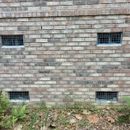Block + brick veneer + air gap: Crawlspace encapsulation questions
After a lot of searching and reading I still need help with a few encapsulation details. My crawlspace averages 5′ tall above grade with double vents all the way around and fiberglass batts in the subfloor, climate zone 2A. The construction is block foundation wall with an air gap and exterior brick veneer down to the footers. From what I’ve read I should close the vents, put up poly sheeting, and add a dehumidifier. Where I get confused is what should I do with the airspace between the block and brick? Should I only close/seal the interior block openings? Should I close both the interior openings and the exterior veneer openings? Should I close only the exterior veneer openings and allow the dehumidified air to access the veneer air gap?
Also, if I choose to remove the batts from the subfloor and replace with rigid foam boards on the walls, do the foam boards go on top of the poly sheeting or below it? Should the poly go all the way up the wall or just high enough to seal against the foam?
Thanks,
Joel
GBA Detail Library
A collection of one thousand construction details organized by climate and house part











Replies
Hi Joel -
I do agree that your crawlspace should move to unvented.
As part of this change, your thermal control layer (rigid insulation) and your air control layer (sealing/taping the rigid insulation) will move to the exterior crawlspace walls. And of course, you must seal the bare dirt floor of your crawlspace as part of this work, sealing it as part of or before you air seal and insulate the exterior walls.
Don't worry about the free-draining space between the brick veneer and your foundation wall; it's outside your air and thermal control layers.
Whether or not your crawlspace will need a dehumidifier depends on a lot of variables, but at a minimum, the crawlspace needs some air movement.
See this GBA resource, which includes options for ventilating your unvented crawlspace: https://www.greenbuildingadvisor.com/article/building-an-unvented-crawl-space.
Peter,
Thanks for the reply and the useful information, it's much appreciated.
- Joel